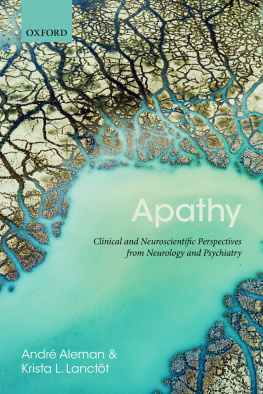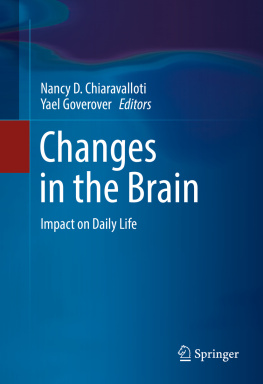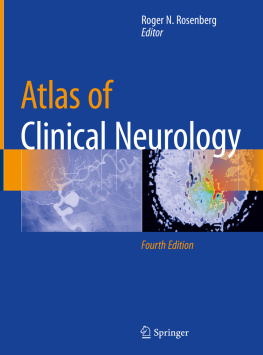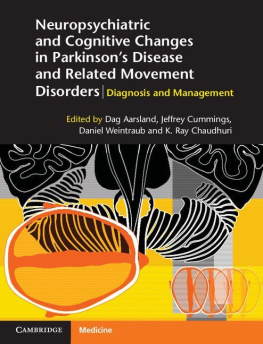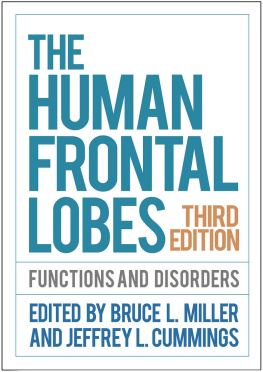Apathy

Great Clarendon Street, Oxford, OX2 6DP,
United Kingdom
Oxford University Press is a department of the University of Oxford.
It furthers the Universitys objective of excellence in research, scholarship, and education by publishing worldwide. Oxford is a registered trade mark of Oxford University Press in the UK and in certain other countries
Oxford University Press 2021
The moral rights of the authors have been asserted
First Edition published in 2021
Impression: 1
All rights reserved. No part of this publication may be reproduced, stored in a retrieval system, or transmitted, in any form or by any means, without the prior permission in writing of Oxford University Press, or as expressly permitted by law, by licence or under terms agreed with the appropriate reprographics rights organization. Enquiries concerning reproduction outside the scope of the above should be sent to the Rights Department, Oxford University Press, at the address above
You must not circulate this work in any other form and you must impose this same condition on any acquirer
Published in the United States of America by Oxford University Press
198 Madison Avenue, New York, NY 10016, United States of America
British Library Cataloguing in Publication Data
Data available
Library of Congress Control Number: 2021932602
ISBN 9780198841807
eISBN 9780192578891
DOI: 10.1093/med/9780198841807.001.0001
Oxford University Press makes no representation, express or implied, that the drug dosages in this book are correct. Readers must therefore always check the product information and clinical procedures with the most up-to-date published product information and data sheets provided by the manufacturers and the most recent codes of conduct and safety regulations. The authors and the publishers do not accept responsibility or legal liability for any errors in the text or for the misuse or misapplication of material in this work. Except where otherwise stated, drug dosages and recommendations are for the non-pregnant adult who is not breast-feeding
Links to third party websites are provided by Oxford in good faith and for information only. Oxford disclaims any responsibility for the materials contained in any third party website referenced in this work.
Preface
Apathy, or a significant reduction of goal-directed activity, is a common and clinically relevant problem for many patients with a neurological or psychiatric condition. It is a prominent and severely debilitating aspect of many such disorders, including among others schizophrenia, depression, traumatic brain injury, stroke, and neurodegenerative diseases (e.g. Alzheimers disease and Parkinsons disease). Patients with apathy show reduced initiative, indolence, and general passivity of thought and action. Apathy involves changes in affect, behaviour, and cognition. No wonder it impacts the lives of patients and their loved ones, especially affecting patients independence and quality of life.
In recent years, there has been an increasing interest in studying apathy in its own right, given the prognostic value of apathy and its impact on daily functioning. Indeed, apathy can manifest itself independently from other neurological and psychiatric conditions and therefore deserves focused investigation. The advent of reliable measures and investigations of underlying mechanisms will also aid the development of novel treatment strategies.
The purpose of this book is to bring together current knowledge regarding apathy, ranging from conceptual insights to measurement, neurobiology, and treatment. For example, conceptual topics include the definition of apathy and the classification of dimensions pertaining to behaviour, cognition, and emotion. In addition, clinical observations suggest that a distinction can be made between different types of apathy. Measurement includes questionnaire and interview approaches, involving information obtained from self-report, informant (relative or close other), or clinician. Different brain circuits may be involved, such as frontoparietal, frontolimbic, and frontostriatal circuits. The neural structures subserving motivation and reward are highly relevant. Treatment has focused on diverse pharmacological approaches, and also psychosocial approaches such as behavioural activation therapy. More recently, neurostimulation has been introduced as a way of increasing brain activation of relevant circuits. Leading experts in the field have been asked to contribute a chapter on a diversity of topics, comprehensively covering different areas of apathy research. Despite the widespread presence of apathy across neurological and psychiatric disorders, much of the research has been done in artificial silos dictated by diseases. It is our hope that bringing together knowledge from across these disciplines will expand progress through cross-fertilization.
The book will be of interest to a wide range of professionals, including clinicians (psychiatrists, neurologists, psychologists, and psychiatric nurses) and researchers in the fields of neurology, psychiatry, and clinical psychology. We also trust that it will benefit students of psychiatry, neurology, clinical psychology, neuropsychology, and related disciplines.
We would like to take this opportunity to thank our colleagues for contributing to this book by accepting our invitation and for their scholarly, informative, and interesting chapters. We are very happy with the contribution of so many leading experts. We also want to thank Danielle Vieira (Sunnybrook Research Institute, Toronto) for her indispensable help in getting the chapters reviewed and sent to the publisher. Finally, we extend our gratitude to Oxford University Press and editor Lauren Tiley for their enthusiasm and help with this book.
Contents
Philippe Robert and Valeria Manera
Moyra Mortby, Bria Mele, Zahinoor Ismail, and David Miller
Danielle Vieira, Celina Liu, and Krista L. Lanctt
Gabriella Santangelo
Zahinoor Ismail, Bria Mele, Zahra Goodarzi, Jayna Holroyd-Leduc, and Moyra Mortby
Sergio Starkstein and Bradleigh Hayhow
Ann Faerden and Andr Aleman
Eliyas Jeffay, Kyrsten M. Grimes, and Konstantine K. Zakzanis
Richard Levy
Ingrid Agartz and Lynn Mrch-Johnsen
Stefan Kaiser and Florian Schlagenhauf
Andr Aleman
Lisa Nobis and Masud Husain
Marcel Riehle, Zuzana Kasanova, and Tania M. Lincoln
Andr Aleman, Jozarni J. Dlabac-De Lange, and Prasad Padala
| AA | Alzheimers Association |
| AAD | auto-activation deficit |
| ACC | anterior cingulate cortex |
| ACT | acceptance and commitment therapy |
| AD | Alzheimers disease |
| AES | Apathy Evaluation Scale |
| AES-C | Apathy Evaluation Scale Clinician reported |
| AES-I | Apathy Evaluation Scale Informant reported |
| AES-S | Apathy Evaluation Scale Self-reported |
| AI | Apathy Inventory |
| aMCI | amnestic mild cognitive impairment |
| APADEM-NH | Apathy in Dementia, Nursing Home |
| AS | Apathy Scale |
| BOLD | |

